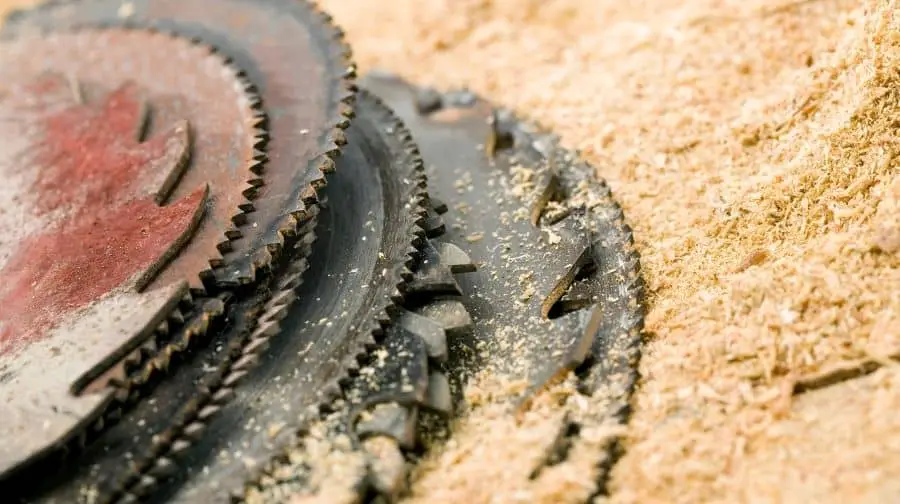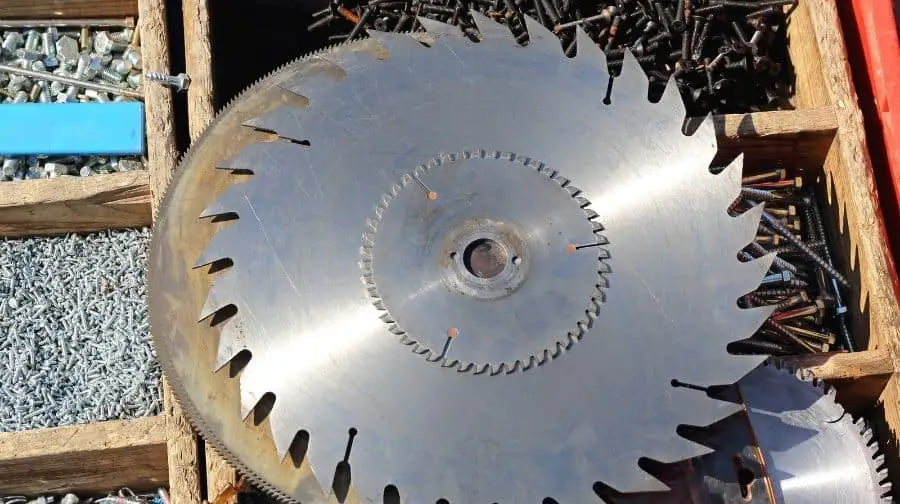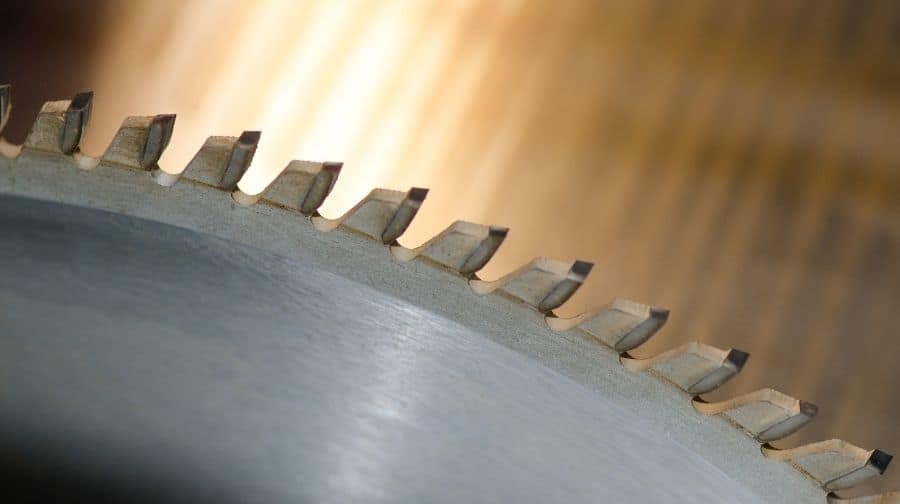
Sharpening your circular saw blade can be a laborious task. It takes time, patience, and the right tools to complete the job correctly. If you are looking for a simple way to sharpen your circular saw blade without any fancy equipment, then this blog post is just for you!
We’ll show you how to use a file as an alternative method of sharpening your circular saw blades with little hassle or expense.
How To Sharpen A Circular Saw Blade With A File
Start by unplugging it from the power source and carefully remove the blade from the saw.
Use a triangular file that is made of coarser grit than your blade, this will take off more metal than if you used one with equal or finer grits. A diamond file is also popular for this.
Secure your blade before starting to file. You can use a vise and if you don’t have one you can get create with what you have around the shop. Make sure not to apply pressure to the tooth blade with your vise.
Slide the file across all teeth about 4 times matching the bevel angle of the tooth.
You can file off the teeth of your saw blade to remove excess metal from the side you want it thinner, or file down both sides if you need a thicker blade for more cutting power and durability.
If there is any file marks left on the surface after using the file, use fine sandpaper to clean them up before sliding the file across the teeth again.
Reinsert your sharp blade into the saw and make sure it spins smoothly with no extra space between each tooth or any burrs on either side of the blade.
If you need a more thorough sharpness, file off both sides until they are completely flat before resharpening them in an incorrect manner or from damage.
If your blade isn’t able to be sharpened please consider reading our article on What To Do With Old Circular Saw Blades by clicking here.
How to sharpen your circular saw blades, the easy way.
Subscribe to The Rocket Factory on Youtube
Best practices for sharpening with a file:
- Work in small sections at a time.
- Use gentle strokes.
- Work in the direction of blade rotation, from right to left or counterclockwise for a positive spin on circular saws.
- Always hold the file at a 45° angle and use small sweeping motions away from cutting teeth. Do not make side-to-side or back-and-forth movements as these may damage the blade.
- If you notice a buildup of sawdust on your file’s teeth, rinse it off with water or white vinegar and continue sharpening.
- When working to create a new cutting edge, start by filing in small increments along one tooth at a time rather than filing across all teeth as once.
- When the file becomes full of metal, use a wire brush to clean it before continuing.
- Use sandpaper or emery cloth in between passes over your file’s teeth for extra sharpening and smoothing.
- The circular saw blade is one of the most important parts of any circular saw because it does all the heavy lifting when cutting wood. Sharpening your circular saw blade regularly is essential for keeping it in good condition. A file can be used to sharpen the teeth on a circular saw blade, but there are some best practices that you should follow when doing so:
Once all parts have been filed down, go over them again thoroughly before reassembling them into their original position.
This is a very simple way to sharpen circular saw blades on your own without any expensive equipment! It should take about 20 minutes or less from start to finish and will give you the same results as if you were using an electric grinder, but not the additional noise pollution. No need for ear protection when sharpening with a file so this method may be preferable in some situations where it would otherwise just be too loud or uncomfortable.
Curious about How To Cut A 2×4 with a Circular Saw Please consider reading our article about the topic by clicking here.

Is it worth sharpening circular saw blades?
Yes, it is worth it because over time you can save a lot of money from not replacing blades each time they get dull. A file costs under $15 so if you spend an hour to sharpen the blade it will pay for itself in spades!
When your circular saw has a dull blade they can make the cutting process more difficult by causing rough edges or potentially ruining your workpiece. Tools that are used for cutting, such as circular saws and jigsaws, need to be kept sharp in order to work more efficiently.
How do I know if my circular saw blade is dull?
You will know if your circular saw blade is getting dull when it makes a more ragged cut. If you are not able to make clean cuts with your circular saw, the teeth on the circular saw blade may be worn down too much and need to be sharpened.
The circular or crosscut teeth of a circular saw blade have two different cutting edges – one side for making ripping cuts and another for crosscutting (or straight) cuts. The larger angled edge can only rip wood apart while its pointier tip will slice through wood much easier in order to make accurate cuts that are necessary when furnishing carpentry joints like dovetails, rabbets, lap joint etcetera). If you notice a circular saw blade that is used for ripping, has teeth with the pointier edge worn down too much then it needs to be sharpened.
– To avoid damaging your circular saw blade, never try to sharpen circular saw blades by running them through a bench grinder or filing on abrasive surfaces while they are spinning – always hold the circular saw blade stationary and file slowly along its length while applying pressure. Use an angle of approximately 15° from perpendicular in relation to the surface being filed. It will take about 20 minutes per inch of thickness but keep in mind that this doesn’t apply if you’re just reshaping old circular saw teeth.
Most people assume that there’s only one way to sharpen their circular saw blades but circular saw blade sharpening doesn’t have to be a complicated process.
Curious about Why Your Circular Saw Keeps Stopping? Please consider reading our article about the topic by Clicking Here.
How to Sharpen Circular Saw Blades
Subscribe to essortment on Youtube
When sharpening circular saw blades, place the blade in a vice and use a flat file to sharpen the edges. Discover how many strokes to use on each side of a saw blade with help from a home remodeling specialist in this free video on sharpening circular saw blades.
How many times can you sharpen a circular saw blade?
You should sharpen a circular saw blade about every 12-18 months or so, depending on the frequency of use.
If you’re sharpen a large circular saw blade with carbide blades and it’s very sharp to start out (or sharpen often), then there might be some benefit in getting an extra set of cutters for that one particular cutter head.
If you sharpen a large circular saw blade with carbide blades and it’s not very sharp to start out (or sharpen rarely), then there might be some benefit in getting an extra set of cutters for that one particular cutter head.
How often should you change a circular saw blade?
You should change the entire blade after about 250 cuts before it becomes too dull to work with. If you are using a carbide-tipped circular saw blade, then they should be replaced around every 100 cuts or so because they will wear down quicker than stainless steel blades.
A circular saw blade can also become worn out if you have been cutting through really hard materials. This can happen to any type of blade, including carbide-tipped blades and stainless steel blades.
Wear on the entire saw blade will often cause it to become duller than normal or even misaligned in its cuts because it cannot fully cut through thick items such as wood or metal. Sometimes you may also notice that your saw blade no longer has a straight edge, but instead is bent and curved.
If you notice any of these signs that your entire circular saw blade may need to be replaced or sharpened with a file.

How do you sharpen a saw blade by hand?
– Use a blade sharpener to sharpen the blade.
– Place blade in the right position for filing and use saw file to remove any burrs or imperfections.
– Clean blade with soap and water after sharpening, then dry it off thoroughly.
There are many different blade sharpeners available on the market. For most blades you will use the blade sharpener with a blade of its own. For more precise work, you might want to invest in one that uses sandpaper and has adjustable angles.
